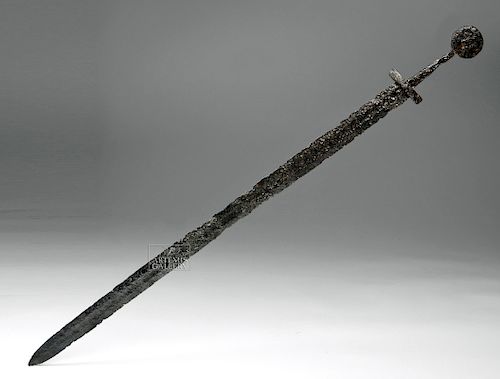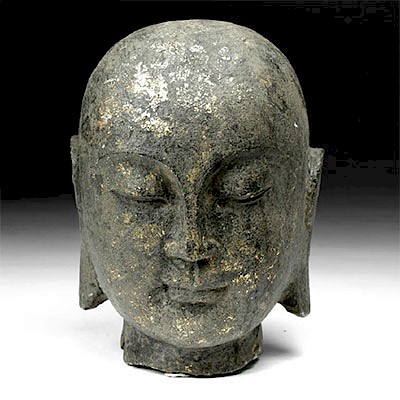Late Viking / Medieval Forged Iron Sword
Lot 88
About Seller
Artemis Fine Arts
686 S Taylor Ave, Ste 106
Louisville, CO 80027
United States
Selling antiquities, ancient and ethnographic art online since 1993, Artemis Gallery specializes in Classical Antiquities (Egyptian, Greek, Roman, Near Eastern), Asian, Pre-Columbian, African / Tribal / Oceanographic art. Our extensive inventory includes pottery, stone, metal, wood, glass and textil...Read more
Estimate:
$11,000 - $16,500
Absentee vs Live bid
Two ways to bid:
- Leave a max absentee bid and the platform will bid on your behalf up to your maximum bid during the live auction.
- Bid live during the auction and your bids will be submitted real-time to the auctioneer.
Bid Increments
| Price | Bid Increment |
|---|---|
| $0 | $25 |
| $300 | $50 |
| $1,000 | $100 |
| $2,000 | $250 |
| $5,000 | $500 |
| $10,000 | $1,000 |
| $20,000 | $2,500 |
| $50,000 | $5,000 |
| $100,000 | $10,000 |
| $200,000 | $20,000 |
About Auction
By Artemis Fine Arts
Nov 29, 2018
Set Reminder
2018-11-29 10:00:00
2018-11-29 10:00:00
America/New_York
Bidsquare
Bidsquare : Holiday Glitz - Ancient / Ethnographic Art
https://www.bidsquare.com/auctions/artemis-gallery/holiday-glitz---ancient-ethnographic-art-3672
What to give this holiday season? Think silver, gold, bronze, shiny, glittery, wearable, festive. We ship worldwide and handle all shipping in-house for your convenience. This is one sale you don't want to miss! Artemis Fine Arts info@artemisgallery.com
What to give this holiday season? Think silver, gold, bronze, shiny, glittery, wearable, festive. We ship worldwide and handle all shipping in-house for your convenience. This is one sale you don't want to miss! Artemis Fine Arts info@artemisgallery.com
- Lot Description
Northern Europe, late Viking to Medieval period, ca. 11th to 12th century CE. A beautiful forged-iron Viking sword that was likely repurposed and modified during the Medieval era. The sword has a long, straight blade with sharpened edges, a shallow fuller running the length of both sides, and an abruptly tapered point. The slender rectangular guard is a separate piece that can move freely along the tang, though it would have been stabilized by the bone, wood, or leather that formed the handle. Though Viking in origin, this sword was likely used in later Medieval times based on the discoid pommel. Typical Viking swords would boast a half-moon-shaped pommel with rounded corners which were usually somewhat flush with the end of the tang. This pommel appears to have been added on later based on the recessed cavity as well as how the tang tip protrudes through the end of the pommel. Swords of this form have been found throughout the Viking world, making this repurposed example one of extreme rarity! Size: 36.75" L x 2.875" W (93.3 cm x 7.3 cm).
A Viking's sword was a hugely valuable object, passed down through families as an heirloom, and was probably the most expensive item that a Viking could own. For example, from the hundreds of items found in Viking burials in Iceland, only sixteen are swords; they are more common in other parts of the Viking world, especially in Norway, but were still a high-status item. A sword given by King Haakon the Good (king of Norway from 934 to 961 CE) to the Icelander Hoskuldur in the Laxdaela Saga was worth a half mark of gold, or the value of sixteen dairy cows, which was a tremendous sum of money for the time.
Provenance: ex-private Green collection, York, United Kingdom
All items legal to buy/sell under U.S. Statute covering cultural patrimony Code 2600, CHAPTER 14, and are guaranteed to be as described or your money back.
A Certificate of Authenticity will accompany all winning bids.
We ship worldwide and handle all shipping in-house for your convenience.
#136705Surface wear and abrasions commensurate with age, surface oxidation as expected, slight bending to overall form of blade and tang, with small chips to blade, guard, tang, and pommel, and some pitting marks. Light earthen deposits within recessed areas. Nice movement to guard.Condition
- Shipping Info
-
All shipping is handled in-house for your convenience. Your invoice from Artemis Gallery will include shipping calculation instructions. If in doubt, please inquire BEFORE bidding for estimated shipping costs for individual items.
-
- Buyer's Premium



 EUR
EUR CAD
CAD AUD
AUD GBP
GBP MXN
MXN HKD
HKD CNY
CNY MYR
MYR SEK
SEK SGD
SGD CHF
CHF THB
THB














